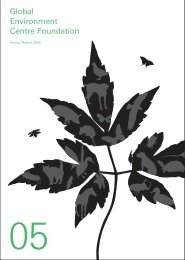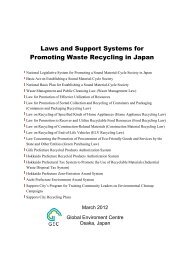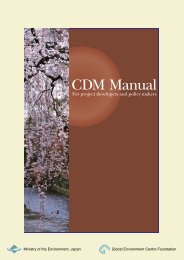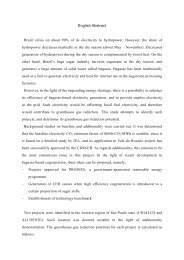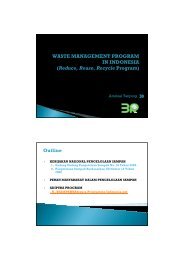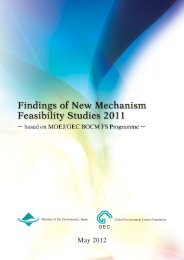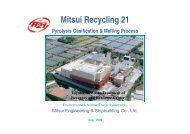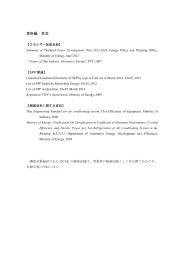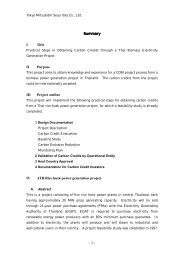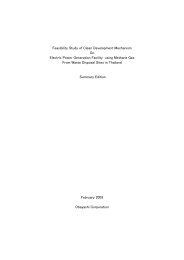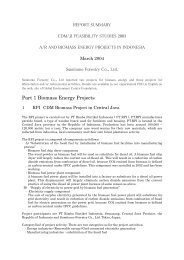PDF File - GEC
PDF File - GEC
PDF File - GEC
You also want an ePaper? Increase the reach of your titles
YUMPU automatically turns print PDFs into web optimized ePapers that Google loves.
3.2.3 Project boundary [PDD section B.3]<br />
As defined in the Glossary of CDM terms, project boundary shall “encompass all GHG emissions<br />
under the control of the project participants that are significant and reasonably attributable to the<br />
CDM project activity”. Project boundary is defined in AMs, usually with regard to the spatial extent<br />
and gases to be included. To illustrate the spatial extent included in the project boundary, it is<br />
useful to include a schematic of the project site and relevant equipments, delineating the project<br />
boundary. As for the gases to be included, use the table format in the CDM-PDD. If the methodology<br />
gives an option to include or exclude certain sources and gases from the project boundary, project<br />
participants should explain and justify the choice.<br />
3.2.4 Baseline identification [PDD section B.4]<br />
Baseline, a fundamental concept in the CDM, is defined as “the scenario that reasonably represents<br />
the GHG emissions that would occur in the absence of the proposed project activity” [CDM M&P,<br />
para. 44]. A baseline shall cover emissions from all gases (CO 2 , CH 4 , N 2 O, HFCs, PFCs, and SF 6 ), sectors<br />
and source categories listed in Annex A of the Kyoto Protocol within the project boundary. Project<br />
participants must identify a baseline scenario for the proposed project activity, according to the<br />
methods and steps specified in the baseline methodology that is applied to the project activity.<br />
A baseline shall be deemed to reasonably represent the GHG emissions that would occur in the<br />
absence of the proposed project activity if it is derived using an approved baseline methodology or<br />
a proposed new baseline methodology that has been approved by the EB. Different scenarios may<br />
be elaborated as potential evolutions of the situation existing before the proposed CDM project<br />
activity. The continuation of the current activity could be one of them; implementing the proposed<br />
project activity may be another; and many others could be envisaged. Baseline methodologies shall<br />
require narrative descriptions of all reasonable baseline scenarios. Based on the selected baseline<br />
methodology, which could be either a methodology already approved by the EB or a proposed<br />
new methodology, project participants must describe how a baseline scenario is identified among<br />
possible baseline scenarios in the CDM-PDD. To elaborate the different scenarios, different elements<br />
shall be taken into consideration, including related guidance issued by the EB. For instance, the<br />
project participants shall take into account national/sectoral policies and circumstances [EB22, Annex<br />
3], ongoing technological improvements, investment barriers, etc.<br />
EB16 agreed on clarifications on the treatment of national and/or sectoral policies and regulations in<br />
determining a baseline scenario. The EB acknowledged that there should be differentiated ways to<br />
address types of national and/or sectoral policies in determining a baseline scenario and had agreed<br />
to a number of definitions. EB22 agreed to revise the clarifications provided at EB16 as outlined below:<br />
(a) A baseline scenario shall be established taking into account relevant national and/or sectoral<br />
policies and circumstances, such as sectoral reform initiatives, local fuel availability, power<br />
sector expansion plans, and the economic situation in the project sector.<br />
(b) As a general principle, national and/or sectoral policies and circumstances are to be taken into<br />
account on the establishment of a baseline scenario, without creating perverse incentives that<br />
may impact host Parties’ contributions to the ultimate objective of the Convention.<br />
(c) Type E+: National and/or sectoral policies or regulations that give comparative advantages to<br />
more emissions-intensive technologies or fuels over less emissions intensive technologies or<br />
fuels.<br />
45



